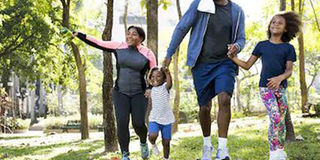Make exercising fun for your children

With so much technology entertaining the world today, children are less physically active at both school and home. Shuttter Image
What you need to know:
• Be active together. Go for a bike ride with your child. Kick a ball around. Explore a nearby park. Children pay close attention to how the adults in their lives act. If you enjoy activities together, you are motivating your children by demonstrating that it is fun for you, too.
• Limit sitting screen time, especially at times of day when it’s light outside and when the weather is good.
Since they are inactive most of the days, a number of children are now becoming obese; developing so many complications of living a sedentary lifestyle yet the ideal behaviour of being fit and exercising should be instilled in them at an early age.
There are various benefits of exercising for children according to Dr Nobert Bwana, a physiotherapist at Physique fitness Centre.
These can include developing stronger bones and muscles, proper blood circulation, stronger heart, stronger immunity, better performance in class, keeping a healthy body weight, emotional wellbeing and developing bonds and relationships with other children.
How to support children
Children copy what they see others do, especially in the home. As a parent or guardian, it is important to be a good role model when it comes to exercise.
Some parents today restrict their children from playing outside for fear of getting dirty or even hurting themselves but Dr Bwana recommends that parents set aside time to play so that they can associate with other children.
Some schools are now incorporating physical activity as part of their curriculum to help children who may have physical talents have a self-discovery of what they are able to do.
Swimming lessons at schools for example are very essential and more than just a life skill.
Children in their later years can earn from it while keeping fit at the same time.
“For children and teenagers to grow up with a healthy lifestyle, it is important that they are physically active and eat healthy foods every day. It is, therefore, important that they get full support from the family and where possible, let the whole family get involved in a particular activity,” Dr Bwana remarks.
The games
According to Quraish Golooba, a physiotherapist at Case Hospital, as a parent or guardian, it is sensible that you choose games and activities that are suitable for your child’s age and medical condition if any.
“Do not wait for the child to grow up. It is advisable to introduce games early enough so that they become used to this type of routine. For younger children, it is good to introduce free play, where the parent can also get involved,” he says.
He adds that, “When your child becomes a teenager, introduce them to games such as football, netball, basketball or engage in activities such as walking to the market with them. You can also teach them how to swim if there are no such lessons at their schools.”
Since some teenagers may want to be independent, you can encourage them to go for a walk, play football or ride a bicycle with their peers.
Golooba says, “You can also engage in activities that strengthen muscles and bones such as skipping the rope, athletics (especially at school where they will meet healthy competition) and sports such as basketball. Most importantly, let them explore new ideas.”
Level of straining
Normal children should be able to do the usual exercises and the intensity and frequency can increase gradually with their age according to Dr Bwana.
He says, “If your child has a blood circulation problem such as haemophilia; or chronic diseases such as sickle cell anaemia or asthma, contact their paediatrician to explain to you if there are any likely complications and what degree of straining their body can take.”




